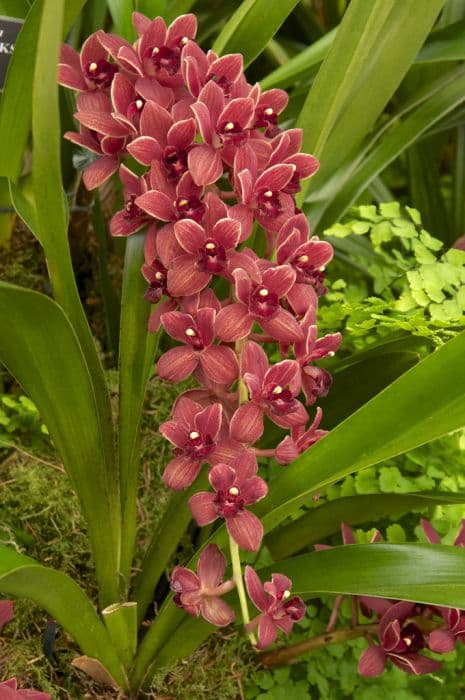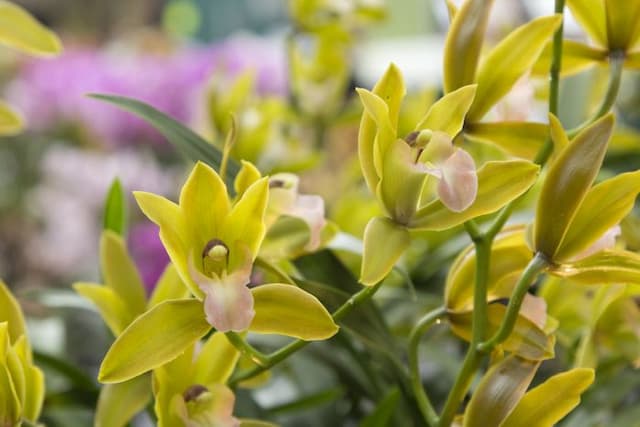Fragrant Ladies' Tresses Spiranthes odorata 'Chadd's Ford'

ABOUT
The Spiranthes odorata 'Chadd's Ford', commonly known as the fragrant lady's tresses, is a distinctive and attractive perennial plant renowned for its spiraling clusters of flowers. The plant typically has a robust green appearance, with narrow, grass-like leaves that create a tidy, vertical posture. The flowers are particularly striking, blooming in a unique spiral arrangement that resembles a twisted braid or corkscrew along the flower spike. They are usually white in color and exude a delightful sweet fragrance. Each individual flower has a delicate, almost orchid-like shape, with a lip that is usually slightly larger than the other petal segments. The floral display of the fragrant lady's tresses is further enhanced by the contrast with the green foliage, creating an eye-catching presence in garden settings or natural areas. The bloom period comes during the cooler months, adding interest to the late-season landscape. Despite its elegant appearance, the plant is known for its hardiness and can thrive in a variety of soil conditions, making it a popular choice among gardeners and plant enthusiasts looking for an addition that brings both beauty and resilience to their green spaces.
About this plant
 Names
NamesFamily
Orchidaceae.
Synonyms
Fragrant Ladies' Tresses, Marsh Ladies' Tresses, Fragrant Spiranthes, Southern Ladies' Tresses.
Common names
Spiranthes odorata.
 Toxicity
ToxicityTo humans
Spiranthes odorata, commonly known as fragrant ladies’ tresses, is not widely recognized as a toxic plant to humans. There is limited information available regarding its potential toxicity upon ingestion. However, as with any plant, individual allergic reactions or sensitivities could occur. If irritations or symptoms arise after handling or ingesting plant material, it is advisable to seek medical attention.
To pets
Fragrant ladies’ tresses, which Spiranthes odorata 'Chadd's Ford' is a variant of, is not commonly known to be toxic to pets. There is limited information on its effects if pets consume it, but general caution should be exercised. If a pet displays unusual symptoms after ingesting this plant, it would be best to consult with a veterinarian.
 Characteristics
CharacteristicsLife cycle
Perennials
Foliage type
Deciduous
Color of leaves
Green
Flower color
White
Height
1-2 feet (30-60 cm)
Spread
1 foot (30 cm)
Plant type
Herb
Hardiness zones
6
Native area
North America
Benefits
 General Benefits
General Benefits- Aesthetic Appeal: Adds delicate beauty to gardens with its spiraling white flowers and pleasant fragrance.
- Native Plant: As a local species, it supports regional ecosystems and wildlife more effectively than non-native plants.
- Pollinator Attraction: Draws bees, butterflies, and other beneficial insects, which are vital for pollination and maintaining biodiversity.
- Low Maintenance: Typically requires less care than many non-native ornamental plants after becoming established.
- Drought Tolerance: Once established, it is relatively drought-resistant, making it suitable for xeric or water-wise gardens.
- Seasonal Interest: Provides late summer to fall blooms, a period when many other plants have finished flowering.
- Adaptability: Capable of thriving in a range of conditions from full sun to partial shade and in various soil types.
- Erosion Control: The plant’s root system helps to stabilize soil and prevent erosion, especially in naturalized or wild garden areas.
- Habitat Restoration: Can be used in restoration projects to help re-establish native plant communities.
- Educational Value: Offers opportunities for educational activities regarding plant lifecycles, native species, and ecological gardening practices.
 Medical Properties
Medical PropertiesThis plant is not used for medical purposes.
 Air-purifying Qualities
Air-purifying QualitiesThis plant is not specifically known for air purifying qualities.
 Other Uses
Other Uses- Spiranthes odorata 'Chadd's Ford', commonly known as the Fragrant Ladies' Tresses, can be used in creating natural dyes, particularly from the flowers which may yield subtle hues for textiles.
- The plant's tall, distinctive flowering spikes make it an attractive element for botanical illustration, providing an interesting subject for artists specializing in flora.
- Its unique blossom structure can inspire designs in jewelry, particularly in crafting pendants and earrings that mimic its helical flower arrangement.
- The Fragrant Ladies' Tresses can be utilized in fragrance extraction, as the flowers exude a pleasant vanilla-like scent which is quite desirable in the perfume industry.
- This species may be used in educational settings as an example of spiral phyllotaxy in botany classes, demonstrating the patterns of nature.
- They serve as ornamental inlays in woodworking, potentially pressed and encased in clear resin on tables or other decorative items for a natural, botanical touch.
- The delicate flowers can be incorporated into the art of pressed flower crafts, framed for wall art, or used in scrapbooking projects.
- Spiranthes odorata can act as a natural indicator species due to its specific growing conditions, signaling the health of the ecosystems where it grows.
- In landscape design, these plants can be used to create a 'fairy garden' theme due to their whimsical appearance and enticing fragrance.
- Finally, they can be an integral part of a sensory garden, where their texture and scent contribute to the experience for visitors with visual impairments.
Interesting Facts
 Feng Shui
Feng ShuiThe plant commonly known as Ladies' Tresses is not used in Feng Shui practice.
 Zodiac Sign Compitability
Zodiac Sign CompitabilityThe Ladies' Tresses is not used in astrology practice.
 Plant Symbolism
Plant Symbolism- Resilience: Spiranthes odorata 'Chadd's Ford', commonly known as the fragrant ladies' tresses, often grows in challenging conditions, which symbolizes resilience and the ability to thrive in adversity.
- Purity: The white color of its flowers is often associated with purity and innocence, reflecting untouched beauty.
- Elegance: The delicate and intricate spiral arrangement of the blossom spikes gives this plant an air of elegance and sophistication.
- Simplicity: Despite its ornamental appearance, the fragrant ladies' tresses maintain a form of simplicity, symbolizing a modest and unassuming character.
 Water
WaterThe fragrant ladies' tresses (Spiranthes odorata 'Chadd's Ford') should be kept evenly moist, which typically means watering once every week with about one-quarter of a gallon, depending on the humidity and temperature. During active growth in spring and summer, you may need to water more frequently, always checking the top inch of soil for dryness before watering again. During the dormant period in the colder months, reduce watering but do not allow the soil to completely dry out. It is important to use a gentle watering method, like a watering can with a spout, to avoid disturbing the soil or damaging the plant.
 Light
LightThe fragrant ladies' tresses prefers bright, indirect light, making an east-facing or north-facing window an ideal spot in the home. It can tolerate some mild direct sunlight, particularly in the cooler parts of the day, but too much direct sunlight can burn the leaves. If growing outdoors, provide dappled shade or morning sun with afternoon protection.
 Temperature
TemperatureFragrant ladies' tresses thrives in temperatures between 50 and 80 degrees Fahrenheit. It can survive minimum temperatures down to about 40 degrees Fahrenheit and should not be exposed to temperatures above 85 degrees Fahrenheit for extended periods. The ideal temperature range for this orchid is within moderate room temperatures, avoiding abrupt temperature changes and drafts.
 Pruning
PruningPruning the fragrant ladies' tresses is generally not required but can be done to remove yellow or damaged leaves. The best time to prune is in the spring after blooming, or when new growth is evident. Pruning can help maintain an attractive shape and encourage healthy growth. Use sterilized scissors or pruning shears to make clean cuts.
 Cleaning
CleaningAs needed
 Soil
SoilThe best soil mix for the Fragrant Ladies' Tresses (Spiranthes odorata 'Chadd's Ford') should be rich, moist, and well-draining, with a mix of loam, peat, and sand. The soil pH should be slightly acidic, with an optimal range between 6.0 to 6.5.
 Repotting
RepottingFragrant Ladies' Tresses should be repotted every two to three years, or when the plant has visibly outgrown its current container which could lead to less flowering.
 Humidity & Misting
Humidity & MistingFragrant Ladies' Tresses thrives in high humidity conditions, preferably between 60% to 80%.
 Suitable locations
Suitable locationsIndoor
Provide high humidity, indirect light, and keep soil moist.
Outdoor
Plant in dappled sunlight, moist soil, protect from harsh elements.
Hardiness zone
6-9 USDA
 Life cycle
Life cycleThe life of Spiranthes odorata 'Chadd's Ford', more commonly known as Chadd's Ford fragrant ladies'-tresses, begins with seed germination which occurs in sync with the presence of specific mycorrhizal fungi, essential for nutrient uptake. Following germination, a small rosette of leaves develops, a phase that can last for several years as the plant establishes itself. The vegetative stage is characterized by the growth of linear-lanceolate leaves during spring and summer, which are basal and form a rosette at ground level. As the plant matures, it enters the reproductive phase in late summer or early fall, producing a spiral spike of distinctive, fragrant, white flowers that are pollinated by insects, particularly bees. After pollination, the flowers produce tiny seeds that are dispersed by wind, completing the reproductive cycle. With the onset of winter, the above-ground portions of the plant die back, while the underground tuberoids that store energy enable the plant to survive and resprout the following spring.
 Propogation
PropogationPropogation time
Late summer
Propogation: Spiranthes odorata 'Chadd's Ford', commonly known as the fragrant ladies' tresses, is propagated primarily by division. This method involves splitting the plant into several sections, each with a portion of the root system attached. It is best performed in the early spring prior to new growth or in the fall after flowering has finished. To execute this, gently lift the plant from the soil, taking care not to damage the roots. Then, using a sharp knife or spade, divide the clump into smaller sections, ensuring each has at least one growth point. These sections can then be replanted into a moist, well-draining growing medium, maintaining the same planting depth as the original plant. Care should be taken to keep the soil consistently moist until the new divisions are well-established.









